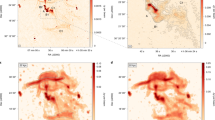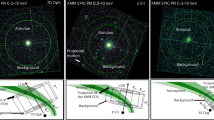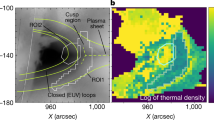Abstract
The solar neighbourhood is the closest and most easily studied sample of the Galactic interstellar medium, an understanding of which is essential for models of star formation and galaxy evolution. Observations of an unexpectedly intense diffuse flux of easily absorbed 1/4-kiloelectronvolt X-rays1,2, coupled with the discovery that interstellar space within about a hundred parsecs of the Sun is almost completely devoid of cool absorbing gas3, led to a picture of a ‘local cavity’ filled with X-ray-emitting hot gas, dubbed the local hot bubble4,5,6. This model was recently challenged by suggestions that the emission could instead be readily produced within the Solar System by heavy solar-wind ions exchanging electrons with neutral H and He in interplanetary space7,8,9,10,11, potentially removing the major piece of evidence for the local existence of million-degree gas within the Galactic disk12,13,14,15. Here we report observations showing that the total solar-wind charge-exchange contribution is approximately 40 per cent of the 1/4-keV flux in the Galactic plane. The fact that the measured flux is not dominated by charge exchange supports the notion of a million-degree hot bubble extending about a hundred parsecs from the Sun.
This is a preview of subscription content, access via your institution
Access options
Subscribe to this journal
Receive 51 print issues and online access
$199.00 per year
only $3.90 per issue
Buy this article
- Purchase on Springer Link
- Instant access to full article PDF
Prices may be subject to local taxes which are calculated during checkout




Similar content being viewed by others
References
Bowyer, C. S., Field, G. B. & Mack, J. E. Detection of an anisotropic soft X-ray background flux. Nature 217, 32–34 (1968)
Bunner, A. N. et al. Soft X-ray background flux. Nature 223, 1222–1226 (1969)
Jenkins, E. B. & Meloy, D. A. A survey with Copernicus of interstellar O VI absorption. Astrophys. J. 193, L121–L125 (1974)
Sanders, W. T., Kraushaar, W. L., Nousek, J. A. & Fried, P. M. Soft diffuse X rays in the southern Galactic hemisphere. Astrophys. J. 217, L87–L91 (1977)
Cox, D. P. & Anderson, P. A. Extended adiabatic blast waves and a model of the soft X-ray background. Astrophys. J. 253, 268–289 (1982)
Snowden, S. L., Cox, D. P., McCammon, D. & Sanders, W. T. A model for the distribution of material generating the soft X-ray background. Astrophys. J. 354, 211–219 (1990)
Cox, D. P. Modeling the local bubble. Lecture Notes Phys. 506, 121–131 (1998)
Cravens, T. E. Heliospheric X-ray emission associated with charge transfer of the solar wind with interstellar neutrals. Astrophys. J. 532, L153–L156 (2000)
Lallement, R. The heliospheric soft X-ray emission pattern during the ROSAT survey: inferences on local bubble hot gas. Astron. Astrophys. 418, 143–150 (2004)
Welsh, B. Y. & Lallement, R. Highly ionized gas in the local ISM: some like it hot? Astron. Astrophys. 436, 615–632 (2005)
Koutroumpa, D., Lallement, R., Raymond, J. C. & Kharchenko, V. The solar wind charge-transfer X-Ray emission in the 1/4 keV energy range: inferences on local bubble hot gas at low z. Astrophys. J. 696, 1517–1525 (2009)
Frisch, P. C. The nearby interstellar medium. Nature 293, 377–379 (1981)
Cox, D. P. & Snowden, S. Perspective on the local interstellar medium. Adv. Space Res. 6, 97–107 (1986)
Lallement, R. The local interstellar medium: peculiar or not? Space Sci. Rev. 130, 341–353 (2007)
Welsh, B. Y. & Shelton, R. L. The trouble with the local bubble. Astrophys. Space Sci. 323, 1–16 (2009)
Cravens, T. E. Comet Hyakutake X-ray source: charge transfer of solar wind heavy ions. Geophys. Res. Lett. 24, 105–108 (1997)
Galeazzi, M. et al. DXL: a sounding rocket mission for the study of solar wind charge exchange and local hot bubble X-ray emission. Exp. Astron. 32, 83–99 (2011)
Möbius, E. et al. Synopsis of the interstellar He parameters from combined neutral gas, pickup ion and UV scattering observations and related consequences. Astron. Astrophys. 426, 897–907 (2004)
Frisch, P. C. The galactic environment of the Sun. J. Geophys. Res. 105, 10279–10290 (2000)
Snowden, S. L. et al. First maps of the soft X-ray diffuse background from the ROSAT XRT/PSPC All-Sky Survey. Astrophys. J. 454, 643–653 (1995)
Koutroumpa, D. et al. Charge-transfer induced EUV and soft X-ray emissions in the heliosphere. Astron. Astrophys. 460, 289–300 (2006)
Burlaga, L. F. & Ness, N. F. Voyager 1 observations of the interstellar magnetic field and the transition from the heliosheath. Astrophys. J. 784, 146 (2014)
Puspitarini, L., Lallement, R., Vergely, J. L. & Snowden, S. L. Local ISM 3D distribution and soft X-ray background: inferences on nearby hot gas and the North Polar Spur. Preprint at http://arxiv.org/abs/1401.6899 (2014)
Snowden, S. L. et al. Pressure equilibrium between the local interstellar clouds and the local hot bubble. Astrophys. J. Lett. (in the press)
Acknowledgements
We thank the personnel at NASA’s Wallops Flight Facility and the White Sands Military Range for their support of payload development, integration and launch, and the technical personnel at the University of Miami, NASA’s Goddard Space Flight Center and the University of Michigan for their support of the instrument’s development. This work was supported by NASA award numbers NNX11AF04G and NNX09AF09G. D.K. and R.L. acknowledge financial support for their activity through the programme ‘Soleil Héliosphère Magnétosphère’ of the French space agency CNES, and the National Program ‘Physique Chimie du Milieu Interstellaire’ of the Institut National des Sciences de l'Univers (INSU). M.C. and N.E.T. are employed through the Center for Research and Exploration in Space Science and Technology (CRESST) and the University of Maryland, Baltimore County, Baltimore, Maryland, USA.
Author information
Authors and Affiliations
Contributions
Y.U., N.E.T., M.G., D.M., M.R.C., F.S.P. and S.T.L. contributed to hardware development. Y.U., N.E.T., M.G., D.M., M.R.C., F.S.P., M.C., D.K., K.D.K. and K.M. contributed to launch operations. M.G., D.M., Y.U., N.E.T., M.R.C., D.K., K.D.K., K.M., T.C., I.P.R., S.L.S., E.U. and B.M.W. contributed to data reduction and analysis. D.K. and R.L. prepared the neutral integral distributions. All authors discussed the results and commented on the manuscript.
Corresponding author
Ethics declarations
Competing interests
The authors declare no competing financial interests.
Extended data figures and tables
Extended Data Figure 1 DXL count rates versus time during flight.
Count rate of Counter-I (red) and Counter-II (black) as a function of time during launch. The DXL observation started off the cone, moved towards the nose of the cone (first scan) and back (second scan) at about 0.7 degrees per second, then performed an Earth scan at about 10 degrees per second to measure the instrument background (fast scan), returned to the nose of the cone, and then performed another scan off the cone (third scan) and back to the nose (fourth scan), for a total of four slow scans along the cone and one fast scan. The gradient up and down the He focusing cone is evident. The error bars are s.e.m.
Extended Data Figure 2 The DXL detector response.
Effective grasp (solid angle times area) for the DXL Counter-I (red) and Counter-II (black), compared with the ROSAT 1/4-keV (R12 band) effective area (blue).
Rights and permissions
About this article
Cite this article
Galeazzi, M., Chiao, M., Collier, M. et al. The origin of the local 1/4-keV X-ray flux in both charge exchange and a hot bubble. Nature 512, 171–173 (2014). https://doi.org/10.1038/nature13525
Received:
Accepted:
Published:
Issue Date:
DOI: https://doi.org/10.1038/nature13525
This article is cited by
-
Periodic interstellar scintillation variations of PSRs J0613–0200 and J0636+5128 associated with the Local Bubble shell
Science China Physics, Mechanics & Astronomy (2023)
-
Scientific objectives of the Hot Universe Baryon Surveyor (HUBS) mission
Science China Physics, Mechanics & Astronomy (2023)
-
Non-equilibrium ionisation plasmas in the interstellar medium
Astrophysics and Space Science (2021)
-
A three-dimensional map of the hot Local Bubble using diffuse interstellar bands
Nature Astronomy (2019)
-
Solar wind charge exchange: an astrophysical nuisance
The Astronomy and Astrophysics Review (2019)
Comments
By submitting a comment you agree to abide by our Terms and Community Guidelines. If you find something abusive or that does not comply with our terms or guidelines please flag it as inappropriate.



